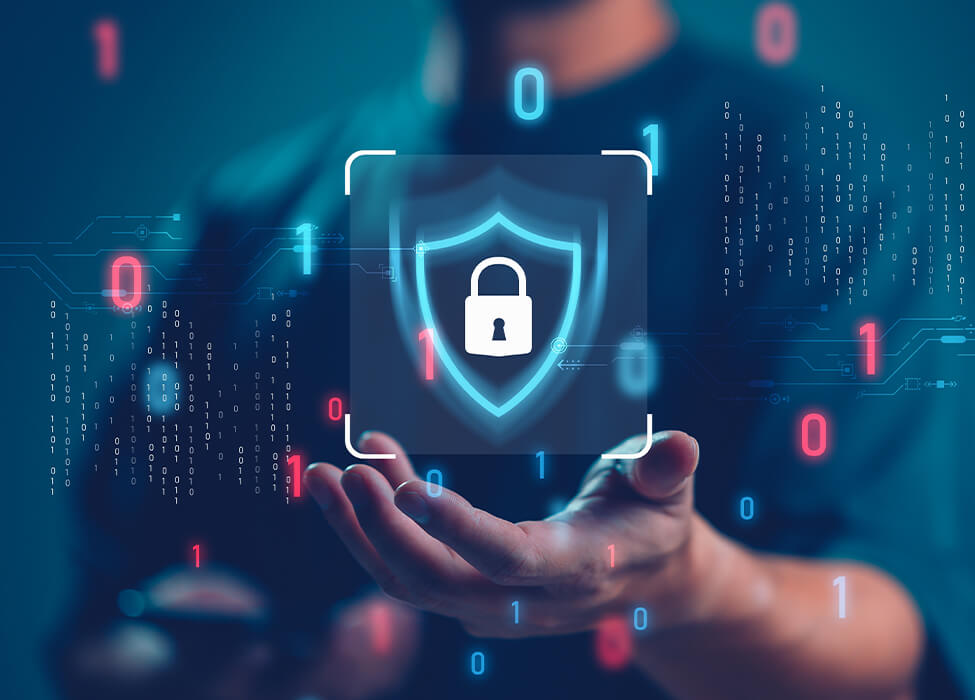The digital landscape constantly evolves, and so do the threats we face in cyberspace. Traditional security methods need help to keep pace with increasingly sophisticated attacks. This is where artificial intelligence (AI) steps in, offering a powerful new weapon in the fight for digital defense.
2022 wasn't just the year generative AI emerged; it was the year AI redefined cybersecurity. Machine learning has been our trusty shield against threats and fraud for years, but generative AI demands a new way of thinking. This is due to two key factors:
Data Sensitivity: Generative AI deals with susceptible data, requiring a heightened awareness of security and ethical implications.
Unprecedented Advancements: Generative AI brings groundbreaking capabilities that empower security teams with a fresh approach to building robust defenses.

The Ever-Shifting Threat Landscape
Cybercriminals are constantly innovating, developing new techniques to bypass security measures. Phishing emails are becoming more personalized, malware is evolving to evade detection, and zero-day attacks can come out of nowhere to wreak havoc on our systems. These evil tech ninjas are constantly honing their skills and developing new tactics to infiltrate our defenses. Their innovation has made cybersecurity an arms race, where traditional methods struggle to keep pace.
Here's a breakdown of some key challenges:
Phishing Emails: Gone are the days of generic "Dear Customer" emails. Attackers craft highly personalized messages, often leveraging social media or leaked data to target specific individuals and their interests. These emails can appear to come from trusted sources like colleagues, banks, or even friends, making them incredibly deceptive.
Evolving Malware: Today's malware is no longer a clumsy brute force attacker. Malicious software is becoming increasingly sophisticated, employing techniques like code obfuscation and polymorphism to bypass traditional detection methods. This makes it more difficult for security software to identify and isolate threats before they wreak havoc.
Zero-Day Attacks: These are the ultimate nightmares for security teams—vulnerabilities that are completely unknown and, therefore, have no existing patches. Cybercriminals are constantly searching for these zero-day vulnerabilities, and once they're exploited, the damage can be extensive before a fix is developed.
Analyst Overload: The sheer volume of threat data that security systems generate can be overwhelming. Security analysts are bombarded with alerts, making it difficult to distinguish genuine threats from false positives. This information overload can lead to alert fatigue, where analysts become desensitized and miss critical warnings.
The constant innovation by cybercriminals creates a complex and ever-evolving threat landscape. Traditional security measures are often playing catch-up, leaving businesses and individuals vulnerable.
The big question is how to secure your data and infrastructure from such attacks?

The Power of AI in Cybersecurity
AI offers a unique set of capabilities that can revolutionize cybersecurity by acting as an intelligent partner in defense. Unlike traditional rule-based systems, AI can continuously learn and adapt to cybercriminals' ever-evolving tactics.
Machine learning algorithms can analyze vast amounts of data – network traffic, user behavior, threat intelligence – to identify subtle patterns and anomalies that might signify an attack. This allows AI to detect zero-day attacks and highly targeted phishing attempts and even predict future threats based on emerging trends.
Here are some of the key ways AI is transforming the field:
Advanced Threat Detection: AI can analyze vast amounts of data from network traffic, logs, and user behavior to identify anomalies that might indicate a cyberattack. It can learn from past attacks to recognize patterns and predict future threats.
Automated Incident Response: AI can automate time-consuming tasks like incident analysis and containment, allowing security teams to focus on more strategic issues.
Enhanced Security Operations: AI can streamline security workflows, prioritize alerts, and suggest remediation actions, freeing up valuable time for human analysts.
Continuous Threat Hunting: AI can continuously monitor systems for suspicious activity, even in the absence of specific alerts. This proactive approach significantly reduces the window of opportunity for attackers.
Phishing and Social Engineering Detection: AI can analyze email content, sender information, and user behavior to identify sophisticated phishing attempts that might bypass traditional filters.
With AI constantly monitoring and learning, security teams can shift from a reactive to a proactive defense, anticipating and mitigating threats before they cause significant damage.
The Human-AI Partnership
AI is not a silver bullet for cybersecurity. However, it is a powerful tool that can significantly augment human capabilities. Security analysts will continue to play a crucial role in setting strategies, overseeing AI systems, and investigating complex incidents. AI can empower these professionals by automating mundane tasks and providing them with the insights they need to make informed decisions.

Reaktr.ai: At the Forefront of AI-Powered Cybersecurity
Reaktr.ai is at the forefront of AI-powered cybersecurity solutions. Leveraging advanced AI to provide comprehensive threat detection, investigation, and response capabilities, Reaktr can help:
Detect Threats in Real Time: Continuously monitor networks for suspicious activity and identify threats in real time, minimizing potential damage.
Automate Workflows: Automate time-consuming tasks like incident analysis and containment, allowing security teams to focus on strategic decisions.
Enable Proactive Defense: Provide security teams with the insights they need to proactively identify and address vulnerabilities before they can be exploited.
Reaktr’s SecAi: SecAi offers a multi-layered approach to securing your GenAI infrastructure and detecting vulnerabilities. It goes beyond traditional security by focusing on the final output and validating every step of the GenAI ecosystem. This includes the training data used to build your AI models, the underlying Large Language Models (LLMs) themselves, how these models are implemented and integrated with other systems, and finally, how the final AI product is consumed. By scrutinizing each layer, SecAi can identify potential loopholes and weaknesses that could be exploited by malicious actors, helping to maintain the overall security and integrity of your GenAI environment.
By leveraging the power of AI, Reaktr.ai empowers organizations to build a more robust and efficient security posture.
The Future of Cybersecurity is AI-Driven
The future of cybersecurity is undoubtedly AI-driven. As AI technology continues to evolve, we can expect even more sophisticated solutions that will enable us to stay ahead of the ever-changing threat landscape. By embracing AI and fostering a human-AI partnership, we can build a more secure digital future for everyone.
Want to learn more? Connect with us and we can answer your questions.


